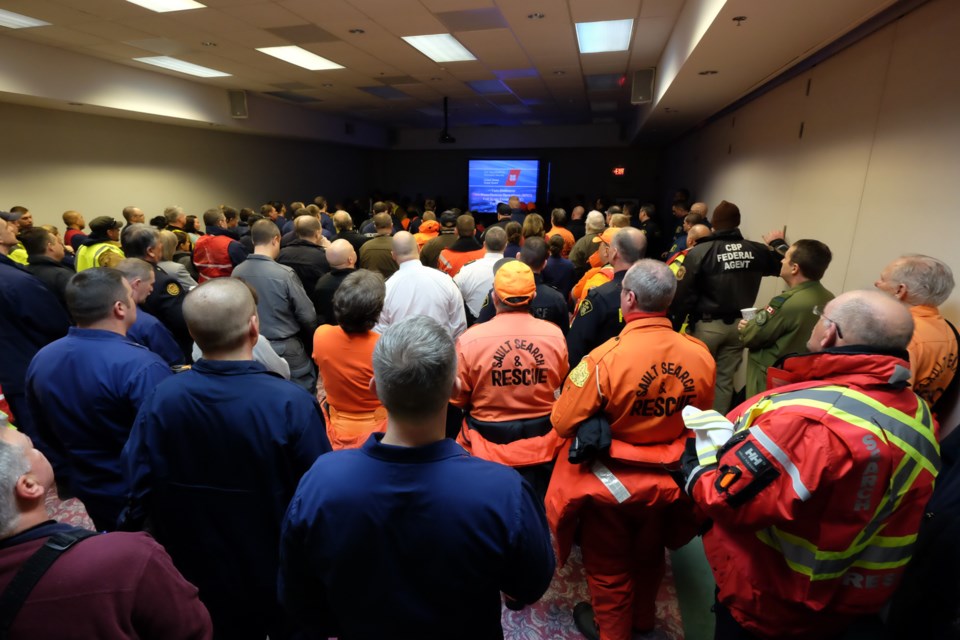Around 200 military and civilian personnel from various Emergency Response organizations in the United States and Canada worked together in a simulated plane crash and mass-rescue exercise over the St. Mary’s River on Saturday.
The event, dubbed “Twin Endeavour” because of the “twin” Sault cities, was funded and hosted by the United States Coast Guard (USCG) who put on similar mass rescue exercises every year in different areas around the Great Lakes; happening about every four years in the Sault area.
The simulation started off at 8:45 a.m. when members of the USCG, Sault Search and Rescue, Bay Mills Fire Department, and Superior Township Fire Department responded to fictitious 911 calls that a plane had crashed over the frozen St. Mary’s River.
According to the simulation, a two-engine passenger plane from ‘Tundra Airlines’ experienced icing on its wings during its descent to Sault Ste. Marie Airport which resulted in it losing altitude until it crashed and scattered 37 passengers, 3 crew, and plane debris on both sides of the border over the ice.
The destroyed plane was signified by wooden crates, some pallets, and a blue tarp while smoke grenades and a smoldering fire pit and helped simulate the environmental conditions of a plane crash site.
The exercise required emergency response personnel to assess the condition of the crew and passengers, which were represented by discarded immersion survival suits, and then carry them off in stretchers and UTV’s.
Also among the simulated bodies were 3 ice-fishers who, according to the crash-story, were injured or killed by plane debris.
Part of the rescue required rescuers to pull people out of cut holes in the ice and a diver with the Michigan State Police actually entered the water in a mock flight data recorder, or ‘black box’, recovery.
After the plane crash simulation, an H-65 Dolphin Helicopter from Coast Guard Air Station Traverse City also performed several airlift exercises while spectators looked on.
While the hectic simulation took place over Waiska Bay, support staff and other personal coordinated with the on-scene rescuers in control rooms at the Casino.
Organizers wanted to recreate the real-life conditions of staff having to coordinate several organizations without being able to actually see the scene itself.
Inspector Monique Rollin of Sault Ste. Marie Police Service was in charge of coordinating the Canadian organizations involved in the exercise.
These organizations included city police and fire, several branches of the OPP, Sault Area Hospital, Sault Ste. Marie Airport, and the Joint Rescue Coordination Centre out of CFB Trenton, amongst others.
Sault Ste. Marie Search and Rescue was also there as the only Canadian organization that went out onto the ice, actually rescuing 10 of the 43 simulated persons.
Rollin said improving “communication and interoperability” was the main focus of the operation.
“(In the event of a real emergency) our biggest problems are going to be inter-agency and cross-country communications. We’re not worried so much about rescuers as they’re going to show up, even good Samaritans, (but) if we don’t organize it jointly then it just becomes a mess,” said Rollin.
Amongst organizations from the United States were USCG, Michigan State Police, Border Patrol, Immigration and Customs, and Bay Mills Fire Department.
USCG Contingency Preparedness Specialist Steven Keck was the head coordinator for the entire exercise.
Keck said the simulation was designed to be as realistic as possible and incorporated agencies that would most likely be called on scene in a real event.
“We chose to perform this type of simulation because, for this area of responsibility, the most likely scenario where we would have a mass causality incident would be an airline crash since we don’t have ships traveling this way in the winter,” said Keck.
Command posts were set up at Bay Mills Resort and Casino while the actual on-the-ground rescue simulation took place over the frozen Waiska Bay right beside the casino.
Keck said that, while the U.S. Coast Guard has powerful resources at its disposal, it works with and relies heavily on local organizations in emergency events.
“The Coast guard does not operate in a vacuum. We consider ourselves an extension cord that plugs into local support. We always say ‘all incidents begin and end locally.' The locals are going to be the first ones on the scene and they’re going to be the ones… that turn the lights off at the end,” said Keck.
